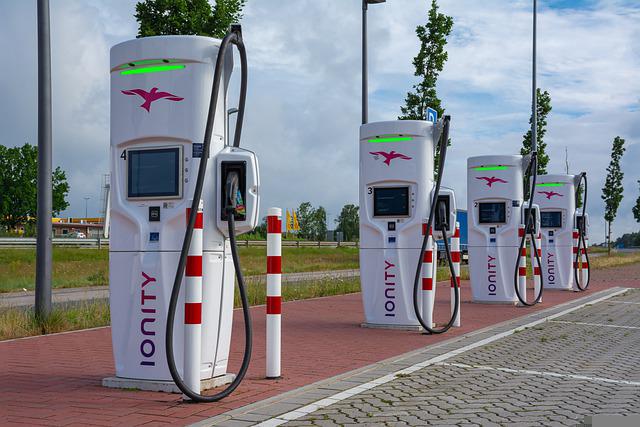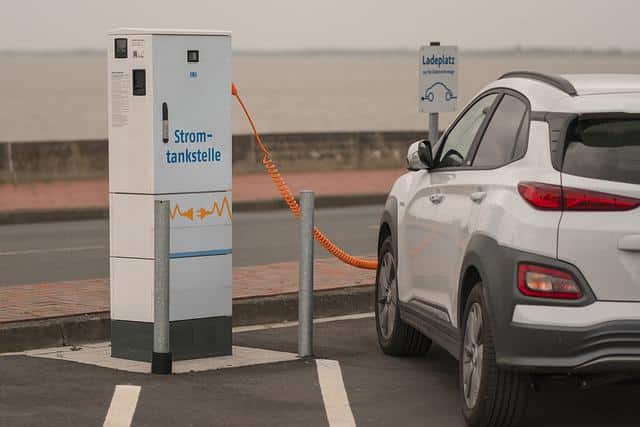800 Volt Charging – Game Changer?
Electric vehicles continue to increase their share of sales. Estimates for when EVs overtaking conventional cars range from 2030 to 2050 with the predicted time continuing to fall. Government subsidies and improvements in charging infrastructure increase the attractiveness of electric vehicles. In this article we will talk about why 800-volt charging will be a game-changer, allowing electric vehicles to charge much faster.

800 Volt Refers To A Type Of Fast Charging Technology
As of late 2022, the majority of public DC fast chargers are built for cars with a 400 volt cell architecture, as that’s been the standard for many years.
Newer fast chargers which support 800 volt charging have started to emerge, at providers like Electrify America and EVGO, and IONITY and Circle K overseas.
Public vehicle chargers, also known as EVSCs or electric vehicle supply equipment, are a relay from a power source that communicates to your car in a basic way to verify the amperage limits before transmitting power into your EV.
By-Passing The EV On-Board Charger
The advanced technology takes place inside your EV.
Inside is an “onboard charger” rated between 6 to 20 kilowatts and does the magic of converting AC power to DC power before before stored in the battery pack.
On-board chargers are large, heavy, and expensive. DC fast chargers perform this exact same function as the on-board charger but on a much larger scale and on the outside of the car.
These large cabinets contain AC to DC converters that charge your battery directly when charging at a DC fast charger.
The power bypasses the on-board charger and goes straight into the battery pack. This allows you to charge your car very quickly.
Fast charging will solve a lot of the range of anxiety issues that people have with electric vehicles. But there are other benefits to fast charging as well.
For example, if you’re on a long road trip and need to charge your car, being able to do it quickly will be very helpful.
How Can You Tell The Difference Between 400 Volt and 800 Volt Public Chargers
At a charging station, you can quickly tell the chargers apart by their maximum output power.
In the US, typically a 150 kilowatt charger will be rated for 400 volts, while 350 kilowatt charges are able to output up to 800 volts.
There are likely differences, but it seems like this is the standard that most companies have landed on.
These DC fast chargers are designed to output a full range of voltages to safely charge electric vehicles.
If you arrive with the very low battery and plug-in the charger, it will accommodate and adjust accordingly.
The 350 kilowatt chargers will also drop down the voltage to work properly with the 400 volt battery pack compatibility was built in from the start.
Porsche Taycan: First EV With 800V charging
The first electric vehicle to feature the 800v charging capability was the Porsche Taycan in 2019.
The range on the battery is a disappointing 277 miles but was compensated slightly for the 800V charging which could complete charging in a mere 23 minutes.
The Taycan battery capacity is 79.2 to 93.4 kWh. If we work backwards that implies a charge rate of 215 kW – the power, or the rate at which energy flows into the battery.
Besides Porsche, the other companies with 800V charging platforms are Audi, Hyundai and Kia.

All of these great facts belie a reality that most Porsche owners don’t have an 800V facility at home.
Residential charging frameworks rely on standard 220V so the Taycan and its brethren would still need about 9-10 hours to fill up its 80 kWh battery.
Don’t Worry About Charging An 800 Volt Porsche Taycan With 400 Volt Charger
What if you bring a Porsche Taycan, which is built on 800 volt architecture, to an old style 400 volt charger? Well, luckily, automakers have planned for that.
Inside of all 800 volt cars are resonant converters which take the 400 volt DC power and increases the voltage so that it can charge the battery pack.
What Other Cars Have 800 Volt Capabilities
There are a few other automakers that have 800 volt architecture including Kia, Hyundai, Porsche, Lucid, and Audi. Note that Tesla is not one of these yet. We already covered the Porsche above.
Audi’s 800 volt is manifested in the Audi RS E-Tron GT which is based on the same platform as the Porsche Taycan.
Hyundai has the electric global modular platform which allows for 800 volt charging capability.
This platform is made exclusively for electric vehicles and includes a battery, motor, and power electric system.
The Hyundai Ioniq 5’s new electric vehicle also employs an 800-volt architecture, unusual for a non-luxury EV.
The Kia EV6 shares a platform with the Hyundai Ioniq 5, also uses an 800-volt system.
Finally the newer Lucid Air also uses an 800-volt system.
800-Volt: 20 Times Faster and Lower Energy Loss
Now we know 800-volt charging is fast such that an EV with an 800-volt charging system can add about 100 miles of range in just 10 minutes – that’s about 30 times faster than a standard Level 2 charger.
And if you’re on a long road trip, being able to quickly recharge your battery can be a lifesaver.
800-volt charging is also more efficient than lower voltage systems.
That means less wasted energy, which translates to savings on your electric bill. And since the charging process is so much faster, you’ll spend less time waiting for your car to charge.
Of course, there are a few things to be aware of when it comes to 800-volt charging. One is that you’ll need special equipment – an 800-volt charger and an EV with an 800-volt charging system.
That means it’s not currently an option for everyone.
Additionally, 800-volt chargers are more expensive than standard Level 2 chargers, so an upfront investment is required. However, the long-term savings on your electric bill may make it worth the initial investment.
So, is 800-volt charging good for EVs? There are definite benefits – it’s fast and efficient. However, there are also a few things to be aware of before making the switch.
But if you’re looking for a way to save time and money on your electric bill, 800-volt charging may be right.
Infrastructure Is Still Behind – We Need More Fast Charging In EVs
The recent increase in electric vehicle (EV) ownership has led to a corresponding demand for reliable and convenient charging solutions.
While most EV owners charge their vehicles at home or work, there is a growing need for public charging infrastructure that can provide a fast and reliable charge when needed.
Future-proofing fast charging infrastructure is essential to meeting the needs of EV owners now and in the future.
There are a few key factors to consider when planning for future-proof fast charging infrastructure.
First, it is important to ensure that the network of chargers is sufficiently dense to meet the needs of EV owners.
Second, the chargers must be able to deliver a high voltage and current, allowing for a fast charge.
Finally, the system must be able to accommodate different types of EVs and new technologies that may come along in the future.
By planning for future-proof fast chargers now, we can ensure EV owners have the reliable and convenient charging solution they need. This will help to increase EV adoption and make our cities cleaner and more sustainable.
Technology around the chargers need to improve as well. The higher voltage calls for thicker cables except that innovation of liquid cooled cables means what used to be heavy and difficult to use becomes light and easier to handle.
Tesla Superchargers And Its 800-Volt Problem
Tesla’s move to open up its Supercharger network collides into the infrastructure problem that we noted above.
Earlier in 2023, Tesla, in agreement with the Biden administration, opened up its Supercharger network to all electric vehicles (EVs) as part of the National Electric Vehicle Infrastructure Formula Program.
Unfortunately, cars that use an 800-volt architecture, such as the Lucid Air, Hyundai Ioniq 6/Kia EV6, and Porsche Taycan/Audi e-tron GT have a compatibility problem.
Tesla’s Superchargers are primarily 400-volt systems and are not designed to deliver optimal charging rates to vehicles with 800-volt systems. As a result, these EVs are unable to draw full power from the Superchargers, leading to significantly slower charging speeds.
For example, Lucid Air owners have reported that they can only reach a charging rate of 50 kW at a Supercharger, which is significantly slower than the speeds these high-end EVs are capable of at compatible charging stations.
High Performance Vehicles Benefit from 800-Volt Charging
The 800-volt architecture is a DC power distribution system used in high-performance electric vehicles.
The main advantage of this system is that it can deliver high power levels with minimal voltage drop, allowing for greater efficiency and range.
In addition, the 800-volt architecture is less susceptible to thermal runaway, meaning it can safely operate at higher temperatures than other systems.
This makes it ideal for high-performance applications such as motorsport and aviation. The 800-volt architecture is also scalable, which can be easily adapted to different power requirements.
This makes it suitable for many electric vehicles, from small city cars to large trucks.
The 800-volt architecture is an important breakthrough in electric vehicle technology and offers significant advantages over other systems.

Electric Cars With 800 Volt Batteries Are Still Rare
Electric cars have been gaining in popularity in recent years due in part to their environmentally friendly credentials.
One of the key components of an electric car is its battery pack, which needs to be able to store a large amount of energy to power the vehicle.
Historically, battery packs have used 400-volt systems, but newer electric cars now use 800-volt systems. There are a few reasons for this switch.
800-volt battery packs can charge more quickly than 400-volt packs, meaning that drivers can get back on the road faster after stopping to recharge.
In addition, 800-volt systems produce less heat than 400-volt systems, meaning that they are more efficient and therefore use less energy.
This is important for electric cars, as reducing energy consumption helps extend the vehicle’s range.
Finally, 800-volt systems are less expensive than 400-volt systems, making them more cost-effective for car manufacturers.
Overall, there are several reasons why electric cars are switching to 800-volt battery packs.
These higher voltage systems offer several advantages regarding charging times, efficiency, and cost.
As electric cars continue to grow in popularity, we will likely see even more advances in battery technology in the years to come.
Wrapping Up
In conclusion, running on such a high voltage gives many advantages to an electric car.
These include a fast charge, less heat produced, and more efficient energy use.
As we move towards a more sustainable future, we will likely see even more advances in electric vehicle technology.
The switch to 800-volt battery packs is just one example of how this technology is evolving.
Only time will tell if these extreme voltages will catch on or if the industry will stick with the tried-and-true 800-volt standard.
